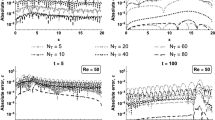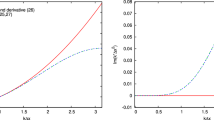Summary
For Courant numbers larger than one and cell Reynolds numbers larger than two, oscillations and in some cases instabilities are typically found with implicit numerical solutions of the fluid dynamics equations. This behavior has sometimes been associated with the loss of diagonal dominance of the coefficient matrix. It is shown here that these problems can in fact be related to the choice of the spatial differences, with the resulting instability related to aliasing or non-linear interaction. Appropriate “filtering” can reduce the intensity of these oscillations and in some cases possibly eliminate the instability. These filtering procedures are equivalent to a weighted average of conservation and non-conservation differencing. The entire spectrum of filtered equations retains a three-point character as well as second-order spatial accuracy. Burgers equation has been considered as a model. Several filters are examined in detail, and smooth solutions have been obtained for extremely large cell Reynolds numbers.
Similar content being viewed by others
References
Patrick J. Roache, Computational fluid dynamics. Hermosa Publishers, 1972.
P. K. Khosla and S. G. Rubin, A diagonally dominant second order accurate implicit scheme. Computers and Fluids 2 (1974) 207–209.
David H. Rudy and Richard S. Hirsch, Comments on the role of diagonal dominance in implicit methods. NASA TM X-73905, May 1976.
N. A. Phillips; An example of non-linear computational instability. The Atmosphere and Sea in Motion, pp. 501–504, Rockefeller Inst. Press, New York (1959).
A. Arakawa, Computational design for long term numerical integration of the equations of fluid motion, two dimensional incompressible flow, Part. I. J. Comput. Physics 1 (1966) 199–243.
Steve A. Piacsek and G. P. Williams, Conservation properties of convention difference schemes. J. of Comput. Physics 6 (1970) 392–405.
F. G. Shuman, Numerical methods in weather prediction: II smoothing and filtering. Monthly Weather Review 85, 11 (1957) 357–361.
R. Shapiro, Smoothing, filtering and boundary effects. Reviews in Geophysics and Space Physics 8 (1970) 359–387.
Sin-I Cheng and G. Shubin, Computational accuracy and mesh Reynolds number. Department of Aerospace and Mechanical Sciences, Princeton University Report NOOO14-75-C-0376-003 July 1976.
Frank P. Taverna Jr. and Richard J. Busch Jr., Burgers equation with smoothing. Class Project, Polytechnic Institute of New York.
Author information
Authors and Affiliations
Additional information
This research was sponsored by the National Aeronautics and Space Administration, Langley Research Center, Hampton, Va., under Grant NSG-1244
Rights and permissions
About this article
Cite this article
Khosla, P.K., Rubin, S.G. Filtering of non-linear instabilities. J Eng Math 13, 127–141 (1979). https://doi.org/10.1007/BF00042748
Issue Date:
DOI: https://doi.org/10.1007/BF00042748




